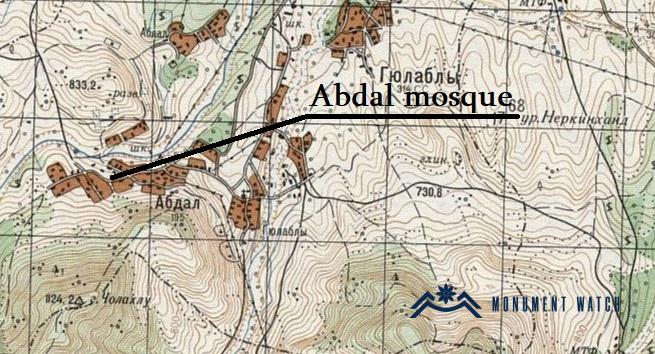The mosque of Abdal village
Location
The mosque is situated in the village of Vazgenashen in the Martuni region of the Republic of Artsakh. During the Soviet administrative period, this village was known as Abdal in the Aghdam region (Balayan 2020, 505).
Historical overview
The Abdal village was founded on the territory of previously inhabited Armenian villages that were abandoned in the second half of the 18th century. A Tatar population settled here in the 19th century (Karapetyan 1999, 228-229). The mosque (Fig. 1) was built in 1878-1879, as evidenced by the handwritten Arabic inscription on the arch of the lintel (Karapetyan 2010, 26-27). The edges of the lintel and the surrounding areas are decorated with vegetable ornaments painted in blue and red (Fig. 2).
Architectural-compositional examination
The mosque is a rectangular structure in layout, constructed from local whitish limestone and burnt brick. It stands out from other mosques in the Artsakh region due to the construction of its walls, which are faced with rough and unevenly cut small and medium-sized stones. Only the cornerstones, the wide arched opening of the vestibule, the main entrance, and the window edges are made of polished stone. The windows are notable as well; even within the same facade, they vary in size and feature different styles and shapes of surrounds (Fig. 3).
The mosque features a wide, arched vestibule at the front, flanked by separate rooms each with its entrance. Inside, the walls are plastered. The roof of the mosque is supported by the outer walls and two octagonal stone pillars in the center of the prayer hall. These pillars are adorned with arrow-shaped arches and vaults made of brick, culminating in brick domes at their apex (Fig. 4). The transition to the domes is facilitated by sails, and there are two domes in total. The mihrab of the mosque is adorned with an arrow-shaped apex. The prayer hall is simple and lacks a second floor. Internally, it is adorned with niches of various sizes and shapes.
In general, the Abdal Mosque bears a striking resemblance to the classical mosques constructed in Artsakh during the late 19th and early 20th centuries, a style largely influenced by Kerbala Sefikhan Karabakh (Fatullaev 1986, 259). Notably, the Abdal village mosque, along with the neighboring Gülablu village mosque and bath, resembling the Fizulu mosque, were all built under the supervision of Sefikhan Karabakh himself (Qarabağlı 1995, 49-53).
The condition before and after the war
The building has been completely preserved and remains undamaged. It was not harmed during the first Artsakh war.
Bibliography
- Balayan 2020 - Balayan V., Outlines of the History of Settlements of the Republic of Artsakh, Yerevan.
- Karapetyan 1999 - Karapetyan S., Monuments of Armenian Culture in the Regions Annexed to Soviet Azerbaijan, Yerevan.
- Karapetyan 2010 - Karapetyan S., Muslim monuments of Armenian architecture of Artsakh, Yerevan.
- Fatullaev 1986 - Fatullaev Sh., Urban development and architecture of Azerbaijan in the 19th-early 20th centuries, Moscow.
- Qarabağlı 1995 - Qarabağlı R., Memar Kərbəlayi Səfixan Qarabaği, Bakı.
The mosque of Abdal village
Artsakh




